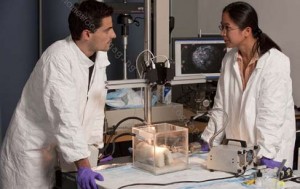 Glaucoma affects some 2.5 million Americans—at least half of whom suffer from loss of vision—and is the second leading cause of blindness in the United States. The disease is the result of pressure built up in the eye that eventually presses on the optic nerve. The mechanics of that pressure is the subject of research currently under way by Thao “Vicky” Nguyen, assistant professor of mechanical engineering at the Whiting School.
Glaucoma affects some 2.5 million Americans—at least half of whom suffer from loss of vision—and is the second leading cause of blindness in the United States. The disease is the result of pressure built up in the eye that eventually presses on the optic nerve. The mechanics of that pressure is the subject of research currently under way by Thao “Vicky” Nguyen, assistant professor of mechanical engineering at the Whiting School.
Nguyen explains that the buildup of pressure within the eye may cause connective tissues— namely the cornea and sclera that form the outer shell of the eye and the optic nerve head that guides the optic nerves from the eye to the brain—to deform excessively and damage the optic nerves. To study the process, her lab uses bovine eyes fresh from the slaughterhouse and donated human eyes. Cow eyes are particularly useful for developing an experimental method, she explains, because they are abundant and close enough in morphology to human eyes to allow her and her colleagues to draw inferences.
Nguyen is studying how pressure exerts stress on the walls, cornea, and sclera—particularly the sclera. “Because the macroscopic and microscopic structure of the sclera and the eye wall are non-uniform, the principles of mechanics tell us that the response of the sclera and eye wall to pressure is also non-uniform,” she notes. “For example, the ‘hoop stress’ is higher where the sclera transitions to the optic nerve head because the material of the optic nerve head is more compliant. Also, thinner regions of the sclera will deform more. These analyses are confirmed by our experiments.”
In experiments aimed at measuring displacements, Nguyen speckles the eye with graphite powder and uses digital image correlation to track the motion of the speckles as the eye deforms. “To get mechanical properties, I have to fit a theoretical model for the stressstrain behavior of the sclera to this experimental data using finite element analysis,” she says.
There is evidence that the stiffness and relaxation time of the sclera in healthy individuals is different from what it is in people with glaucoma; Nguyen is trying to determine whether these differences are caused by the elevation in pressure characteristic in glaucoma or whether they are preexisting conditions that can predispose someone to the disease.
Finding answers to that question could guide development of non-invasive testing procedures that could identify individuals at higher risk for the initial development and rapid progression of the disease, notes Nguyen. “Moreover, the findings can guide the development of new drug therapies to mitigate the progression of the disease—therapies that would stiffen the sclera and reduce deformation.” Her collaborator at Hopkins’ Wilmer Eye Institute, Harry Quigley, director of the Dana Center for Preventative Opthamology, is currently studying such drug treatments, which involve cross-linking collagen.
Nguyen is beginning to move her experiments to other animals, particularly mice, and to donated human eyes. “Comparing similar results of the human and mice studies may provide insight towards the development of gene therapy to reduce the risk of glaucoma,” she notes.
Nguyen says that her research has similar implications for myopia. “The prevalence of myopia is reaching near-epidemic level in several populations, particularly in Asians,” she points out. “By better understanding the corneo-scleral behavior, our work can lead to potential therapy to monitor and alter development of myopia-related disabilities, which currently represent a huge social cost in terms of refractive surgery and visual loss.”




